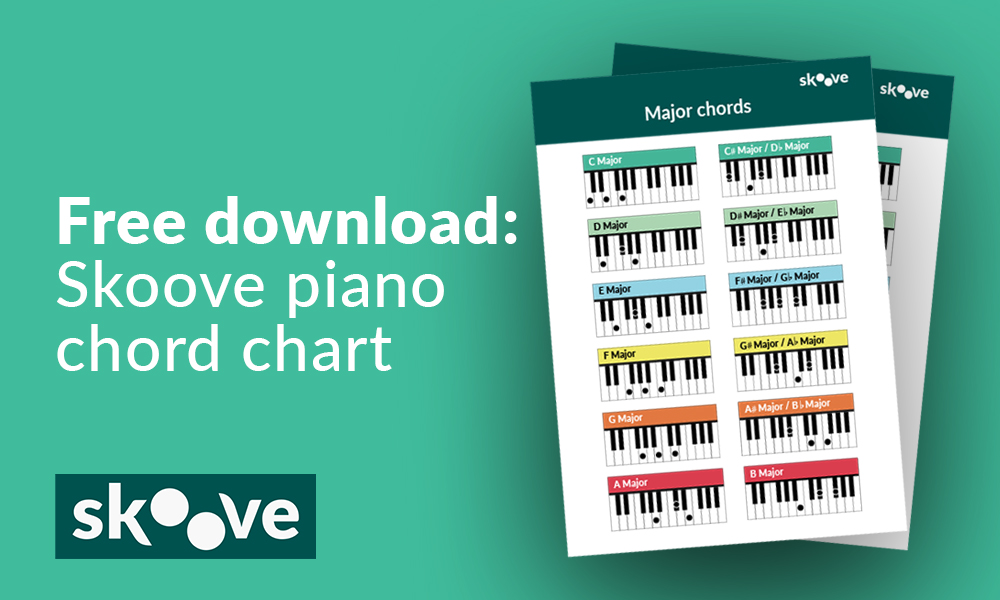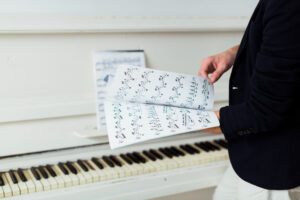If you’re looking for a quick, clear guide to help you get to grips with basic piano chords, you’re in the right place. Our expert musical writers have compiled a beginners guide which will have you playing your favorite songs in no time.
Formed by playing two, three or more notes together, piano chords shape the emotional tone and structure of a piece. The combination of notes within a chord defines its character. In this guide, we will go over all the basics of piano chords and you will leave with a greater understanding of how you can start to use them in your piano playing today!
💡 Searching for a simple cheat sheet? You can download Skoove’s free PDF chart of piano chords right here!

Get started with 6 easy chords
Before looking at some chord charts, it’s handy to know the names of each note on the piano.
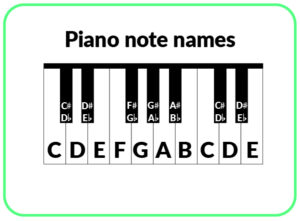
This pattern of notes repeats across the range of the piano at different pitches known as octaves.
Basic piano chords charts
Let’s take a look at some beginner-friendly piano chords notated using piano chord charts. Piano chord charts are an easy visual representation of the notes of each piano chord. For example, check out the C major piano chord chart below:
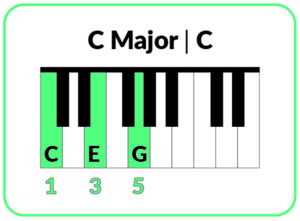
In this chart, we see the notes C – E – G. These are the three notes of a C major chord. With both hands, use your first, third, and fifth fingers to play the chord. See how many places you can find the notes in this order on your piano.
Now that you understand the basics of how a piano chord chart works, take a look at these common piano chords, including D minor, E minor, F major, G major, and A minor:
D minor
The D minor chord is built from the notes D – F – A. Likewise, you can use your first, third and fifth fingers in both hands to play this chord. This fingering can be used across all chords shown in this section. That makes things nice and simple, right?
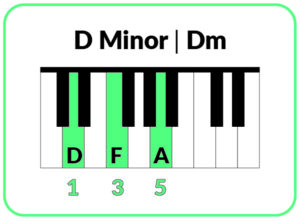
E minor
The E minor chord is built from the notes E – G – B.
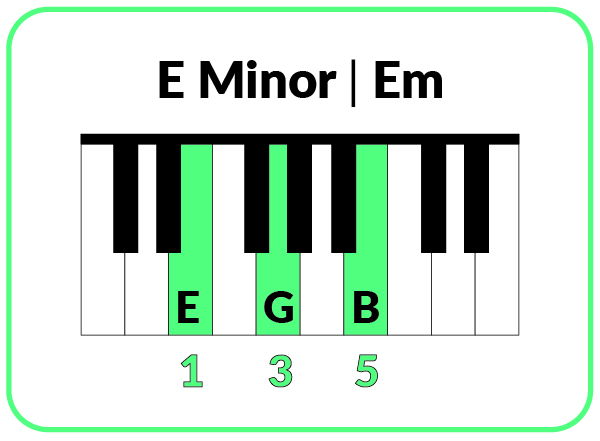
F major
The notes F – A – C make up an F major chord.
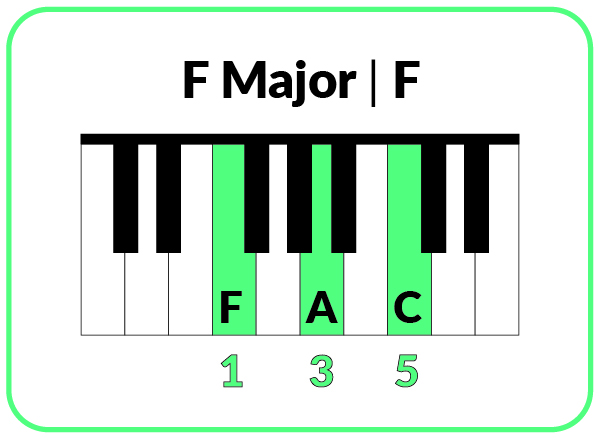
G major
The G major chord is spelled G – B – D.
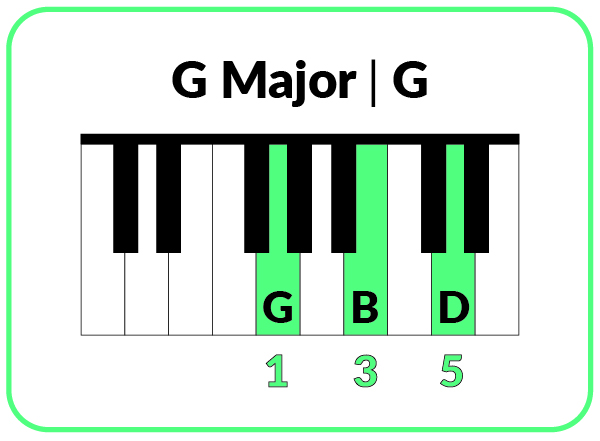
A minor
The A minor chord is spelled A – C – E.
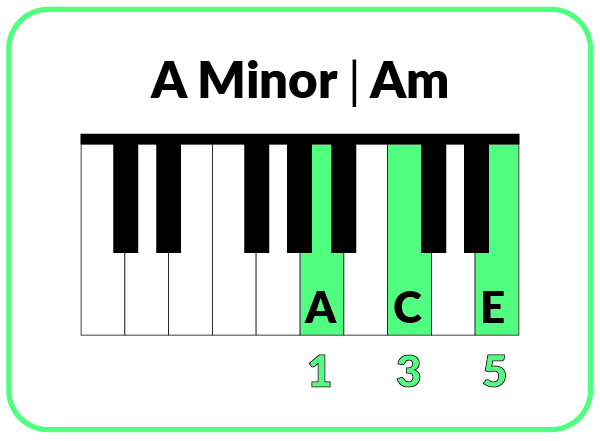
Chords are the basis of all songs and it only takes a few to get started! Once you know these 6 chords you can play “Let It Be” – The Beatles (C, G, Am, F) and “Hallelujah” – Leonard Cohen (C, Am, F, G) and so many more!
Understanding piano chords also helps you decode compositions, predict patterns and grasp the emotions they convey. Proficiency in chords allows you to explore genres like classical, jazz, pop and many more while also enhancing your ability to improvise and compose original music.
Notation of piano chords
Understanding the notation system used for piano chords is essential for songwriters, producers and musicians who want to create impactful and memorable music.
Piano chords are notated using a system of letters and symbols. The letters represent the root note of the chord, while the symbols indicate the quality of the chord. For example, a C major chord is notated as C, while a C minor chord is notated as Cm. You may have noticed when playing the basic chords above that major chords sound happy while minor chords have a more somber sound.
| Chord name | Chord notation |
| C major | C |
| C minor | Cm |
Learning to build your own piano chords
Building piano chords is simple once you grasp the basics. Most chords consist of three notes, called triads, which include a root, third and fifth.
Triads come in different types or chord qualities, determined by the spacing between the notes. For instance, major chords have a major third:
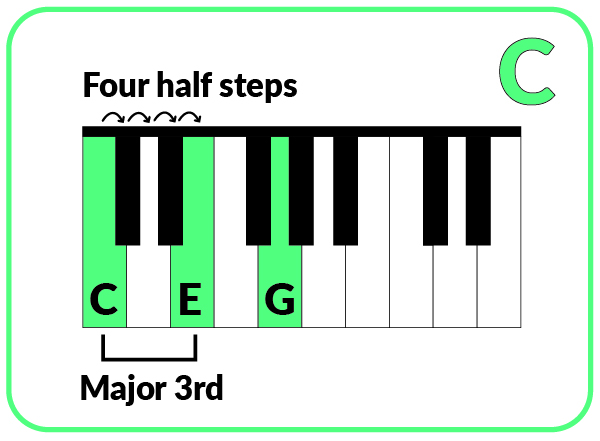
While minor chords have a minor third which is fewer steps away from the root note:
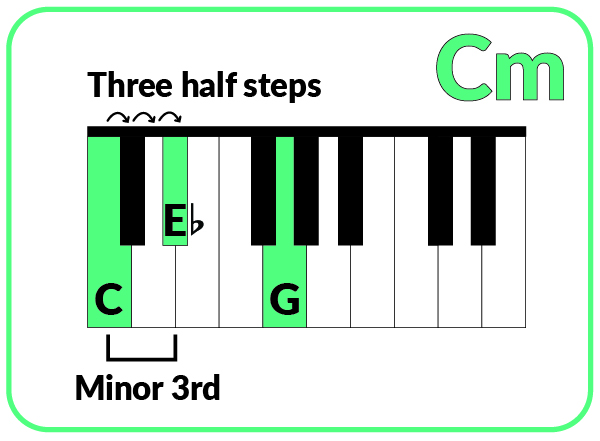
Reading a piano chord chart may seem tricky at first, but it becomes easier with practice. Follow these steps:
- Identify the root note (usually at the top or left of the chart).
- Recognize the chord type (major or minor).
- Observe the highlighted keys (white or black) that indicate the notes to play.
- Visualize the chord shape to guide finger placement.
By consistently practicing with chord charts, you’ll quickly master new chords and improve your piano skills. Try out these different qualities of C chords shown above. Notice the changing difference in sound and spaces between the notes.
Once you have practiced this try and look at the distance between these notes and how these chords are formed. Here are some facts about chord theory in a bit more detail:
Intervals & chord formation
Intervals, the distance between two notes, are key to creating chords. The combination of these intervals forms different types of chords. For example, a major chord is built by stacking a major third (four steps up the scale) and a minor third (three steps). In a C major chord, the interval from C to E is a major third, while from E to G, it’s a minor third.
Root, third, & fifth
The root is the note that gives the chord its name, such as ‘C’ in a C major chord. The third determines whether a chord is major or minor. In C major, ‘E’ is the third, forming a major chord. The fifth adds fullness, like ‘G’ in a C major chord.
C major
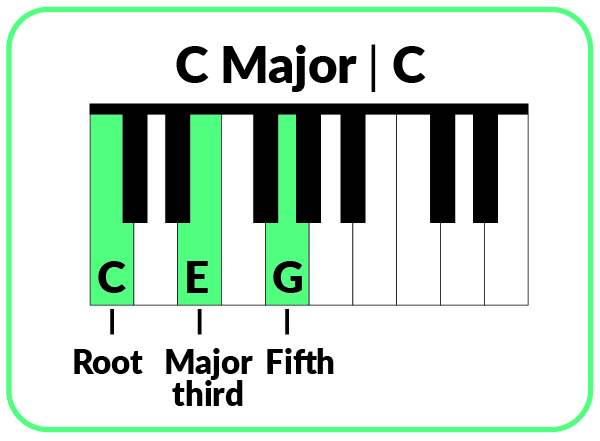
C minor
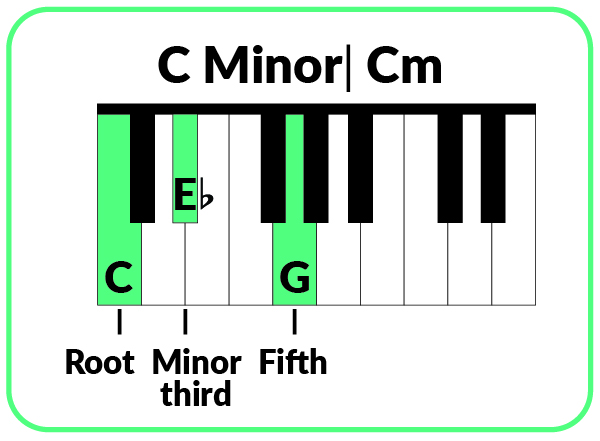
Inversions
Chords can be played in various inversions. For example, in C major, the root position is C-E-G, while the first inversion starts with E, and the second inversion starts with G. These rearrangements offer different sounds without changing the chord’s structure.
Slash chords
If you see a slash chord written down, then this is an inversion. Slash chords are written as a fraction, like C/E, and indicate a chord played over a specific bass note. For example: C/E: A C major chord C-E-G with E as the bass note e.g E -C-G. Slash chords are often used to smooth transitions in progressions.
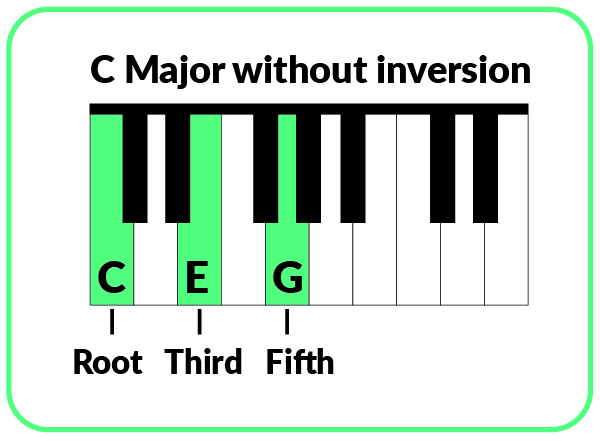
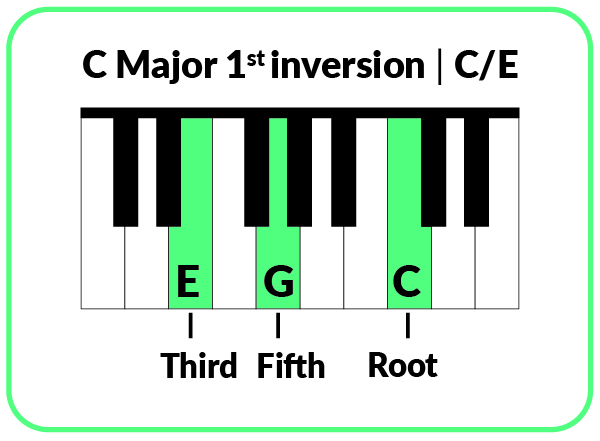
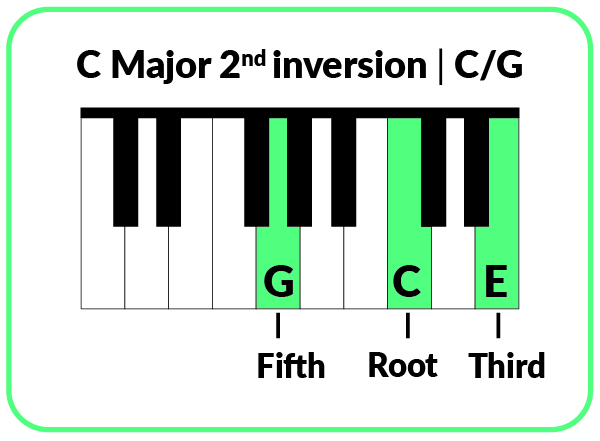
Mastering the basics: exploring chord qualities
Before you can start creating harmonic progressions, there are several types of chords that you should familiarize yourself with. Each one carries a unique sound and plays a distinctive role in music composition. Let’s take a closer look at these fundamental major and minor piano chords for beginners.
Major chords
Major chords are characterized by a joyful and strong sound. They are formed by combining a root note, a major third, and a perfect fifth. For example, a C major chord is formed by combining the notes C, E, and G as we have seen.
The most common major chords on piano are:
- C major: C – E – G
- C♯ major: C♯ – E♯ – G♯
- D major: D – F♯ – A
- E♭ major: E♭ – G – B♭
- E major: E – G♯ – B
- F major: F – A – C
- F♯ major: F♯ – A♯ – C♯
- G major: G – B – D
- A♭ major: A♭ – C – E♭
- A major: A – C♯ – E
- B♭ major: B♭ – D – F
- B major: B – D♯ – F♯
Minor chords
Minor chords, often associated with a somber or melancholic tone, are created using a root note, a minor third, and a perfect fifth. An A minor chord, for instance, includes the notes A, C, and E.
The most common minor chords on piano are:
- C minor: C – E♭ – G
- C♯ minor: C♯ – E – G♯
- D minor: D – F -A
- E♭ minor: E♭ – G♭ – B♭
- E minor: E – G – B
- F minor: F – A♭ – C
- F♯ minor: F♯ – A – C♯
- G minor: G – B♭ – D
- Ab minor: A♭ – C♭ – E♭
- A minor: A – C – E
- Bb minor: B♭ – D♭ – F
- B minor: B – D – F♯
The role of piano chords in music composition
Piano chords serve as the backbone of music composition, shaping the melody, setting the mood, and providing a harmonic framework for the piece. They allow for the creation of diverse sounds, from joyful and bright to somber and melancholic.
Case study: the impact of chords in “Let It Be” by The Beatles
Consider the iconic song“Let It Be” by The Beatles. This song provides a clear illustration of the power and impact of piano chords in music composition.
- C major Chord (C-E-G): The song begins with a C major chord, introducing the song with a strong, happy, and uplifting mood.
- G major Chord (G-B-D): The next chord is G major, which maintains the positive vibe and serves as a perfect transition chord due to its shared notes with the C major chord.
- A minor Chord (A-C-E): The song then transitions to an A minor chord, introducing a touch of melancholy and deepening the emotional complexity of the song.
- F major Chord (F-A-C): Finally, the F major chord is introduced, resolving the minor tension and bringing back the positive mood to round up the verse.
If you’re interested in learning how to play “Let It Be” on the piano, you can check out the Let It Be piano tutorial on Skoove’s blog. YOu can also explore more songs with easy piano chords here.
Piano chords generator
This piano chords generator helps you to find any chord you need and will come in handy if you forget any chords along your way!
💡 If you are reading this from a mobile device, rotate it to display the tool in full width.
2. Choose the “Root” of the chord
3. Choose the “Chord qualities” (major, minor, etc.)
4. Click “Display”
* You can do the same with scales.
** You can invert chords and scales
Taking your chords to the next level
Understanding piano chords is essential, but using them effectively in your playing takes practice. Chords provide the harmonic foundation for any melody. Start by identifying the key of your melody, then experiment with different chords from that key to see how they complement the melody. Typically, melody notes align with the accompanying chord. When composing, choose a key and explore chord progressions that resonate with you. Mastering basic chords will enhance every aspect of your piano journey, as chords and melodies work hand in hand. Use this as a guide to begin your chord exploration!
Looking for a quick cheat sheet? Get Skoove’s free downloadable PDF chart of piano chords here. You can print this out or save it on your device for whenever you need to look up a chord.
FAQ
What are some common mistakes beginners make when learning piano chords?
Common mistakes include neglecting proper finger placement, neglecting proper posture and hand position, not using the correct fingering for chords, and rushing through chord changes without proper accuracy and timing.
How can I practice and memorize piano chords more effectively?
Regular practice is key to memorizing piano chords. Start by practicing chords slowly and accurately, gradually increasing your speed. Practice chord progressions, both in isolation and within songs, to reinforce your chord knowledge.
How do I transition smoothly between different chords?
Smooth chord transitions require practice. Start by practicing each chord individually, then gradually work on transitioning between two chords at a time. Use common fingers or pivot fingers to maintain continuity.
Can I use a keyboard or digital piano to learn piano chords?
Absolutely! Keyboards and digital pianos are excellent instruments for learning piano chords. They often have built-in features, such as chord modes and visual aids, that can assist beginners in learning and practicing chords.








